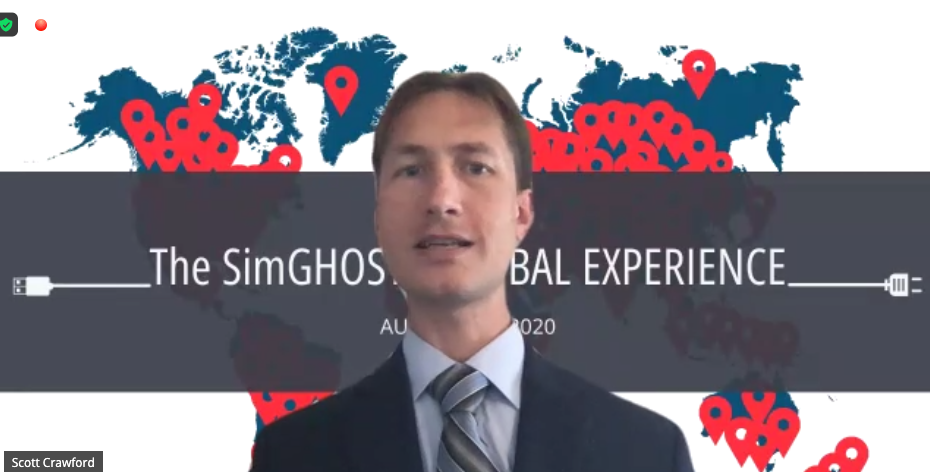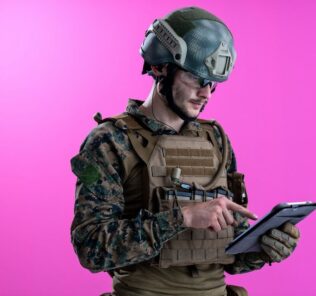SimGHOSTS 2020 Virtual Conference Launches to Support Simulation Technical Operators Around the World
SimGHOSTS, aka The Gathering of Healthcare Simulation Technology Specialists, launched its 2020 event this morning in a live-streamed online conference supporting medical simulation champions from around the world. Sim Techs, administrators, clinical educators and simulation coordinators from countries as far away as Hong Kong, Qatar and Australia joined the live stream this morning for the four days of presentations, interactive networking events, and vendor demonstrations all under the specific focus of technology integrations, staff development, and sim lab designed operations. Here we take a closer look with recapping just a few of the power learning opportunities taking place on the newly relaunched SimGHOSTS.org website this week!
Dr. Scott Crawford, SimGHOSTS Past President and Treasurer opened the virtual event with a special thank you to the SimGHOSTS Staff Kirrian Steer and Jacqueline McBride as well as the entire Board of Directors and volunteers for their help to transition the event to a virtual in-person meeting which was scheduled to take place at Baylor University in Dallas — but had to move online due to the COVID-19 pandemic.
Event sponsors include Pocket Nurse, UbiSim, Echo Healthcare, Nasco Healthcare Laerdal, Intelligent Video Solutions, sim2GROW, MedicFX, and Cardionics.
Sponsored Content:
Keynote Presentation: A Model for Creating Accessible Patient Care
Presented by Bryan Chasko
Bryan Chasko, served as the CTO for Addison Care by Electronic Caregiver, Inc which provides unique technologies to improve patient care, such as wearable technologies and virtual avatars. He noted that by working with healthcare technology, that companies in the industry “can’t keep pace” with how fast new innovations come out. Noting that simulation operators support innovative developments in healthcare simulation, Bryan reminded us that our desire to help others puts us at a key waypoint between technology and people — somewhere in the middle between engineers and patients.
Bryan suggests we all need to start partnerships, within or outside your direct team, to identify a set of shared values to achieve fast results with professional communication. Examples include those from Amazon, the U.S. Army, and leading Football teams, “Show Respect”, “Focus on other people’s success”, and “Start with diversity”. Bryan said when it came to accessibility with patients, teams need to build plans for design testing which includes adaptability, and look for needs that have not yet been served. The ability to develop technical resources has to recognize the end-user throughout the design and implementation process. Focus on what makes you and your program unique, and utilize your potential to serve your community.
Later Today: A 9-Dot Problem Solution to Creating, Sustaining, & Growing a Clinical Simulation Program
Presented by Jeanne Carey, Christie Singbusch & Beverly Price
Sponsored Content:
Building a simulation program and amassing the right people to run it are challenging tasks and the many inherent variables make it difficult to define one strategy for tackling this project. At LHSON Simulation, they gathered their team members and grew our program through a thoughtful approach that focused on traits and duties rather than titles and roles. Every simulation program, regardless of its physical size or scope of activities, has certain jobs that need to be completed and roles that need to be performed. However, how these responsibilities are apportioned and to whom, does not need to abide by some pre-determined title or job description.
They found it helpful to consider three lines of service essential to running a successful simulation center: administration, operations, and education/training. These lines do not run parallel to one another; rather, they intersect at multiple points, as each goes about fulfilling necessary duties and responsibilities. Some of the work performed under administration centers upon management, policy creation & execution, oversight, and foresight. Within operations there is a focus on the technical & mechanical aspects of simulation, as well as logistics. Finally, the education/training line is concerned with those functions that directly impact the participants in simulation.
General Sessions Tacking Place Today Include:
Mass Casualty Exercises: Victim Planning and Prep (Belk & Shablak): This lecture is discussing lessons learned in planning for a large scale mass casualty exercise that involves police, fire, EMS, and hospital systems. Learning Objectives: Recognize the challenges associated with mass casualty simulation planning. Discuss the importance of preplanning and drafting a realistic event schedule. Create a mass casualty simulation plan specific to the participating agencies and local resources.
You Want My Manikin Where? Establishing and Operating an In Situ Simulation Program (Stieber & Fischer): While in situ simulation training can be of significant benefit to learners, it often presents a new set of challenges to the simulation team. This session is currently exploring the many elements you should consider when planning an in situ training session, such as staffing, cost, transportation, and wear and tear on your manikins and other equipment.
Leveraging your IT Staff for Simulation Buy In (Whyte): Here Malcolm Whyte is presenting on how to collaborate with IT staff, sharing how one center developed Group Policy Objects (GPOs) to customize their environment around simulator software requirements, introduced firewall rules for their simulators, and imaged every Windows device running simulator software on the campus domain. The presenter is showing how to develop a broad understanding of how a campus IT network works with simulation centers to assess a simulation center and identify strategies to secure the network and simulator devices.
Teaching Medication Administration: Adapting to the New Normal (Gabriel & Hothaus): For those facing challenges for the Fall Semester stemming from a reduction or limitation in clinical placement options- this session goes over ways champions can adapt and overcome the challenges of teaching and training for medication administration during the Coronavirus pandemic. The presenters are defining the role of simulation in the development of safe medication administration practices for undergraduate nursing students, while recognizing challenges to traditional strategies used to teach safe medication administration to undergraduate nursing students. I
All of the Sessions Are Being Recorded — So You Can Still Join Now and Watch It All!
At only $300 for registration ($250 for active subscribers), participants will gain access to almost 60 live and recorded sessions during the 4 day online event, and for 6 months following the conference! The SimGHOSTS Global Experience is an active event program designed for each participant to be able to tailer their own experience through the event app. Presentations, workshops, and demonstrations can be experience live or on-demand and enhanced with a rich ongoing discussion throughout the session.
Learn, Link, Lead represents three essential qualities demonstrated by those who are driven to use simulation technology to improve quality and safety in healthcare and is the overarching theme for SG20USA. Each of the three elements has multiple applications to healthcare simulation technology and the roles of those working in the field and these will be explored throughout the conference program.
Additional SimGHOSTS 2020 Virtual Event Presentations Include:
- Mass Casualty Exercises: Victim Planning and Prep (Shablak & Belk)
- You Want The Manikin Where? Establishing and Operating an In Situ Simulation Program (Steiber & Fisher)
- Low Cost CCTV System for Healthcare Simulation Recording and Debriefing (Bhimsan)
- Teaching Medication Administration: Adapting to the New Normal (Gabriel & Holthaus of Sim2GROW)
- Beyond the Simulation Lab: Designing Immersive Virtual Reality Simulations (D’Errico)
- Rebuilding and Sustaining an Organizational Foundation to Support Simulation in Academia (Eaton)
- Escape Room Development from the Operations Perspective (Strambo & Mays)
- Integrating SPs into Simulation: Safety Considerations During COVID19 (Higbee)
- Moulage Crash Course: Tips and Tricks (Belk)
- A Checklist Approach to Simulation Problem Solving: Anticipate, Act, Amend (Follmer, Lowther):
- Effective Strategies to Repair, Maintain and Update Simulation Technology (Follmer)
- Blueprint for Success: Building Procedural Skills Events Using Standardized Setup Templates (Phillips & Lincoln)
- Demystifying Grants: Follow These Five Steps to Fund your Simulation Program ((Gabriel & Holthaus)
- Intelligent Simulation: Integrating Artificial Intelligence into Simulation Education (Roye, Hinojosa, White)
- Effective Troubleshooting for Physicians and Healthcare Professionals (Whyte)
- Using the Revised INACSL Standards of Best Practice: Simulation (Mays)
- From Start to Finish, the Multi Patient Event (Hoenig & Haywood of Nasco Healthcare)
- Novice to Expert: A Competency-Based Orientation for Novice Healthcare Simulation Technology Specialists (Hollingsworth, Ockimey, Ford & Gonzalez)
- And Many more!
Visit the SimGHOSTS Website Now for All This & More!
Lance Baily, BA, EMT-B, is the Founder & CEO of HealthySimulation.com, which he started while serving as the Director of the Nevada System of Higher Education’s Clinical Simulation Center of Las Vegas back in 2010. Lance is also the Founder and acting Advisor to the Board of SimGHOSTS.org, the world’s only non-profit organization dedicated to supporting professionals operating healthcare simulation technologies. His co-edited Book: “Comprehensive Healthcare Simulation: Operations, Technology, and Innovative Practice” is cited as a key source for professional certification in the industry. Lance’s background also includes serving as a Simulation Technology Specialist for the LA Community College District, EMS fire fighting, Hollywood movie production, rescue diving, and global travel. He and his wife Abigail Baily, PhD live in Las Vegas, Nevada with their two amazing daughters.
Sponsored Content:




















